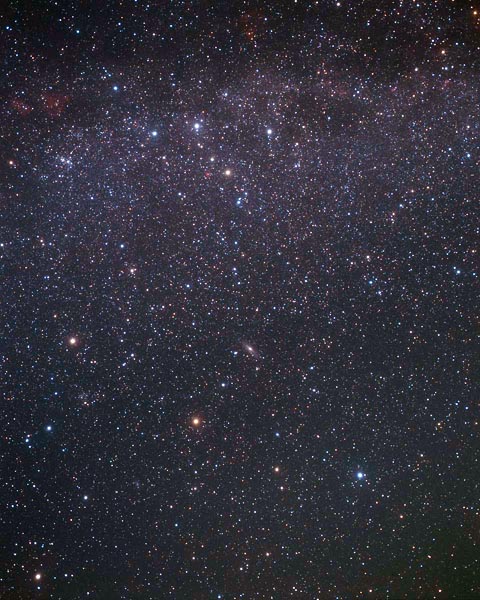DMI image reference. And_1. « Previous || Next » Constellations A » H || Constellations I » V

Roll mouse over picture to see constellation figures and outlines
Image and text ©2008 Akira Fujii/David Malin Images.
In the picture above, north is at the top and the image covers approx. 50 x 62 degrees.
Image centre is located at approx 23:45:00, +45:0:0 (H:M:S, D:M:S, J2000)
Best seen in the early evening in November
From ancient times the constellation of Andromeda has represented a woman and in Greek mythology Andromeda was the daughter of Cepheus and Cassiopeia, king and boastful queen of the Phoenician kingdom of Ethiopia. As punishment for her mother's arrogance she was chained to a rock as a sacrifece to Cetus, then rescued by Perseus whom she subsequently married. There's much more about this in Wikipedia
The modern constellation is the 19th largest in the sky and covers about 720 square degrees but is not very obvious. The three brightest stars of Andromeda form a broad arc south of the distinctive 'W' of Cassiopeia, and under a dark sky the elongated shape of M32 is just visible to the unaided eye. This is by far the best-known object in the field. We also have a wider view of Andromeda, including Lacerta and Triangulum.
Named stars in Andromeda: (Greek alphabet)
Andromeda: Adhil (ξ And), Almak (Almach, γ1 And), Alpheratz (or Sirrah, α And, = δ Peg), Mirach (β And). Sadiradra (δ And),
Adjoining constellations: Aries, Cassiopeia, Cepheus, Lacerta, Pegasus, Perseus, Pisces, Triangulum.
Related images (other sources)
Caltech_M31 M31, the Andromeda galaxy
INT 1. The nucleus of M31 in Andromeda (direct image)
INT 4. NGC 891, edge-on spiral galaxy in Andromeda.